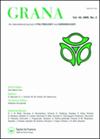含羞草分支的多聚体类型:大小和花粉数量的变化
IF 1
4区 生物学
Q4 PLANT SCIENCES
引用次数: 4
摘要
摘要研究了塞拉多(巴西稀树草原)森林碎片原生含羞草分支的17个物种和3个变种的花粉形态,以扩大对该类群属和种的形态,特别是多聚体的形态的了解,并为该地区发生的Caesalpinoideae物种的花粉研究提供信息。对花粉粒进行乙酰乙酸裂解、测量、定性描述,并在光学显微镜和扫描电子显微镜下进行说明(非乙酰乙酸裂解的花粉粒)。花粉测量数据通过描述性和多变量分析进行检验。研究物种的花粉单位(单体或多体)存在差异,花粉粒在多体中的数量和分布也存在差异。观察到三种花粉类型:Ⅰ型,单子叶花粉粒(Plathymenia reticulata);II型,具有一个锥形末端的多聚物(滴状-小花莲);III型,多聚体,末端均匀,花粉粒不对称分布(Stryphnodedron种);或对称(在羽叶Acacia plumosa、Albizia niopoides、Anadennthera种、Inga marginata、Inga vera和Senegalia种中有16或20个花粉粒,在扭曲叶Enterolobium、Inga edulis和Inga sessionlis中有20多个花粉粒)。多聚体的质量差异和直径的测量,使区分含羞草分支(Caesalpinioideae,Fabaceae)的分类群和确认其广裂特性成为可能。本文章由计算机程序翻译,如有差异,请以英文原文为准。
Polyads types of the mimosoid clade (Caesalpinioideae, Fabaceae): size and pollen numbers variations
Abstract The pollen morphology of 17 species and three varieties of the native mimosoid clade of forest fragments of the Cerrado (Brazilian savanna) was studied in order to expand the knowledge on the morphology of genera and species of this group, in particular on the morphology of polyads, as well as add information to pollen studies for species of Caesalpinioideae occurring in the area. The pollen grains were acetolysed, measured, described qualitatively and illustrated under light microscopy and scanning electron microscopy (not acetolysed pollen grains). Pollen metric data were examined by descriptive and multivariate analysis. The studied species showed differences on the pollen units (monads or polyads) and variations in number and distribution of pollen grains in the polyads. Three pollen types were observed: type I, pollen grains in monads (Plathymenia reticulata); type II, polyads with one tapered end (drop shape – Calliandra parviflora); type III, polyads with uniform ends with asymmetrically distributed pollen grains (Stryphnodendron species); or symmetrically (with 16 or 20 pollen grains in Acacia plumosa, Albizia niopoides, Anadenanthera species, Inga marginata, Inga vera and Senegalia species and more than 20 pollen grains in Enterolobium contortisiliquum, Inga edulis and Inga sessilis). The qualitative differences and the measuremets of the diameters of the polyads, made it possible to distinguish the taxa and to confirm the eurypalynous character of the mimosoid clade (Caesalpinioideae, Fabaceae).
求助全文
通过发布文献求助,成功后即可免费获取论文全文。
去求助
来源期刊

Grana
生物-植物科学
CiteScore
2.10
自引率
11.10%
发文量
23
审稿时长
>12 weeks
期刊介绍:
Grana is an international journal of palynology and aerobiology. It is published under the auspices of the Scandinavian Palynological Collegium (CPS) in affiliation with the International Association for Aerobiology (IAA). Grana publishes original papers, mainly on ontogony (morphology, and ultrastructure of pollen grains and spores of Eucaryota and their importance for plant taxonomy, ecology, phytogeography, paleobotany, etc.) and aerobiology. All submitted manuscripts are subject to initial appraisal by the Editors, and, if found suitable for further consideration, to peer review by independent, anonymous expert referees. All peer review is single blind and submission is online via ScholarOne Manuscripts.
 求助内容:
求助内容: 应助结果提醒方式:
应助结果提醒方式:


